Analysis of Business Decision Making and Investment for XYZ Corp.
VerifiedAdded on 2023/01/06
|8
|1360
|28
Report
AI Summary
This report analyzes the business decision-making process within XYZ Corporation, a budget hotel chain operating in the UK and Europe. The report focuses on evaluating investment projects using payback period and Net Present Value (NPV) calculations. Project A (Software Project) and Project B (Laundrette Project) are assessed, with the payback period and NPV calculated for each. The analysis reveals that while Project A offers a shorter payback period, Project B has a higher NPV, suggesting it's the more financially viable option. The report also discusses financial and non-financial factors that influence business decisions, such as gross profit margins, market growth, and competition. The conclusion emphasizes the importance of investment appraisal techniques in making informed business choices, enabling companies to capitalize on opportunities and achieve economic benefits.

Business Decision
Making
Making
Paraphrase This Document
Need a fresh take? Get an instant paraphrase of this document with our AI Paraphraser

Contents
INTRODUCTION...............................................................................................................................3
MAIN BODY.......................................................................................................................................3
CONCLUSION....................................................................................................................................7
REFERENCES....................................................................................................................................8
INTRODUCTION...............................................................................................................................3
MAIN BODY.......................................................................................................................................3
CONCLUSION....................................................................................................................................7
REFERENCES....................................................................................................................................8
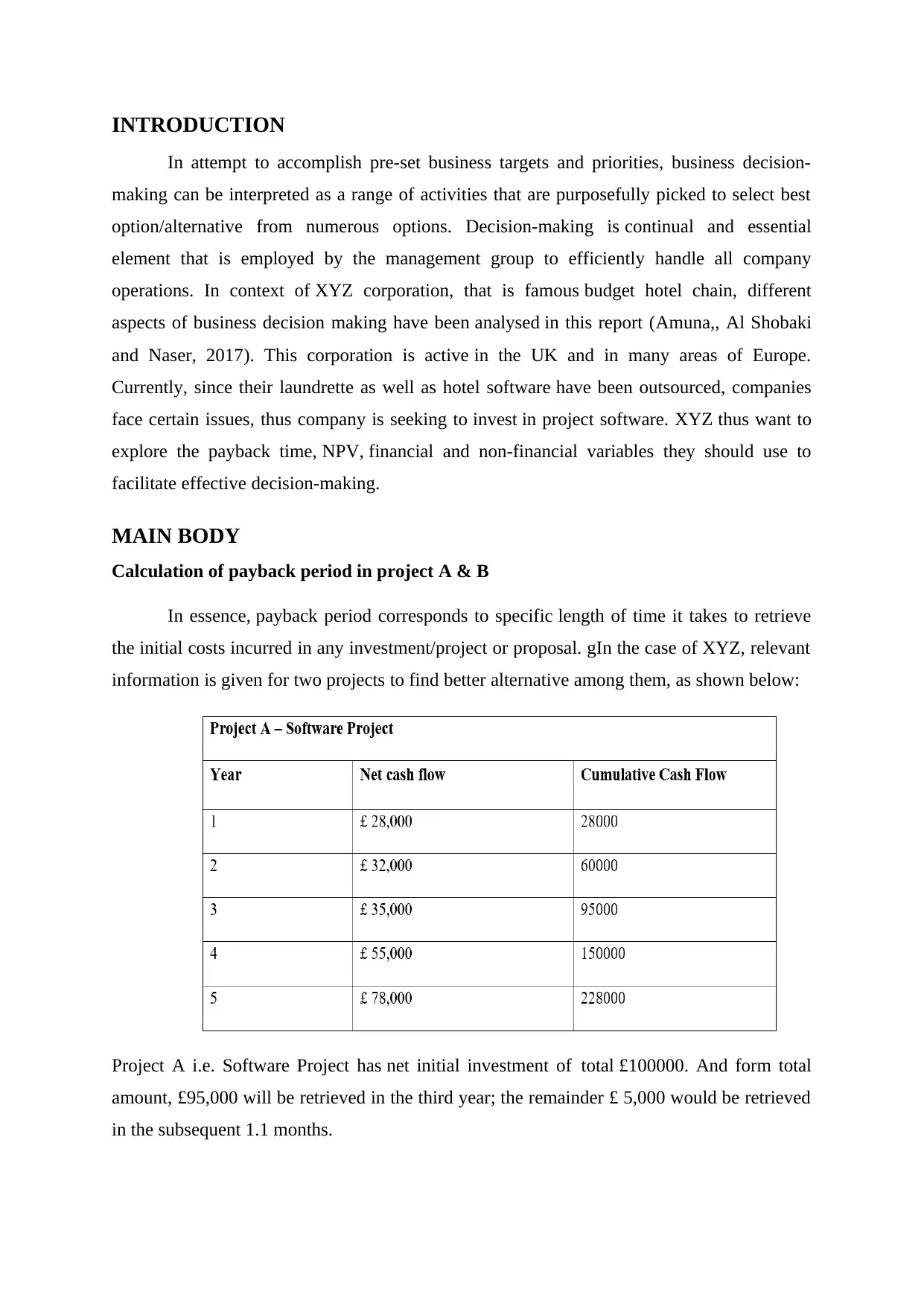
INTRODUCTION
In attempt to accomplish pre-set business targets and priorities, business decision-
making can be interpreted as a range of activities that are purposefully picked to select best
option/alternative from numerous options. Decision-making is continual and essential
element that is employed by the management group to efficiently handle all company
operations. In context of XYZ corporation, that is famous budget hotel chain, different
aspects of business decision making have been analysed in this report (Amuna,, Al Shobaki
and Naser, 2017). This corporation is active in the UK and in many areas of Europe.
Currently, since their laundrette as well as hotel software have been outsourced, companies
face certain issues, thus company is seeking to invest in project software. XYZ thus want to
explore the payback time, NPV, financial and non-financial variables they should use to
facilitate effective decision-making.
MAIN BODY
Calculation of payback period in project A & B
In essence, payback period corresponds to specific length of time it takes to retrieve
the initial costs incurred in any investment/project or proposal. gIn the case of XYZ, relevant
information is given for two projects to find better alternative among them, as shown below:
Project A i.e. Software Project has net initial investment of total £100000. And form total
amount, £95,000 will be retrieved in the third year; the remainder £ 5,000 would be retrieved
in the subsequent 1.1 months.
In attempt to accomplish pre-set business targets and priorities, business decision-
making can be interpreted as a range of activities that are purposefully picked to select best
option/alternative from numerous options. Decision-making is continual and essential
element that is employed by the management group to efficiently handle all company
operations. In context of XYZ corporation, that is famous budget hotel chain, different
aspects of business decision making have been analysed in this report (Amuna,, Al Shobaki
and Naser, 2017). This corporation is active in the UK and in many areas of Europe.
Currently, since their laundrette as well as hotel software have been outsourced, companies
face certain issues, thus company is seeking to invest in project software. XYZ thus want to
explore the payback time, NPV, financial and non-financial variables they should use to
facilitate effective decision-making.
MAIN BODY
Calculation of payback period in project A & B
In essence, payback period corresponds to specific length of time it takes to retrieve
the initial costs incurred in any investment/project or proposal. gIn the case of XYZ, relevant
information is given for two projects to find better alternative among them, as shown below:
Project A i.e. Software Project has net initial investment of total £100000. And form total
amount, £95,000 will be retrieved in the third year; the remainder £ 5,000 would be retrieved
in the subsequent 1.1 months.
⊘ This is a preview!⊘
Do you want full access?
Subscribe today to unlock all pages.

Trusted by 1+ million students worldwide
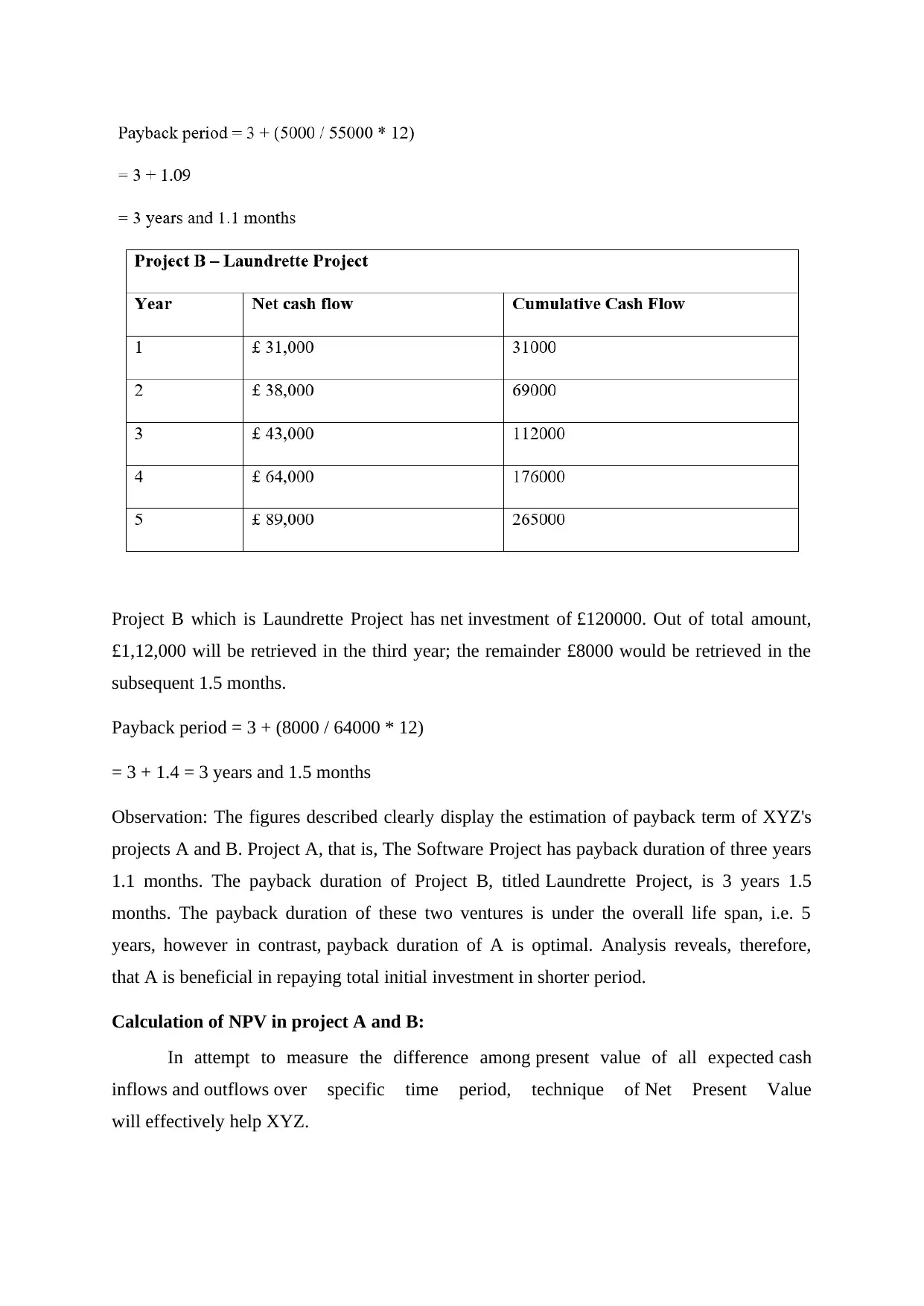
Project B which is Laundrette Project has net investment of £120000. Out of total amount,
£1,12,000 will be retrieved in the third year; the remainder £8000 would be retrieved in the
subsequent 1.5 months.
Payback period = 3 + (8000 / 64000 * 12)
= 3 + 1.4 = 3 years and 1.5 months
Observation: The figures described clearly display the estimation of payback term of XYZ's
projects A and B. Project A, that is, The Software Project has payback duration of three years
1.1 months. The payback duration of Project B, titled Laundrette Project, is 3 years 1.5
months. The payback duration of these two ventures is under the overall life span, i.e. 5
years, however in contrast, payback duration of A is optimal. Analysis reveals, therefore,
that A is beneficial in repaying total initial investment in shorter period.
Calculation of NPV in project A and B:
In attempt to measure the difference among present value of all expected cash
inflows and outflows over specific time period, technique of Net Present Value
will effectively help XYZ.
£1,12,000 will be retrieved in the third year; the remainder £8000 would be retrieved in the
subsequent 1.5 months.
Payback period = 3 + (8000 / 64000 * 12)
= 3 + 1.4 = 3 years and 1.5 months
Observation: The figures described clearly display the estimation of payback term of XYZ's
projects A and B. Project A, that is, The Software Project has payback duration of three years
1.1 months. The payback duration of Project B, titled Laundrette Project, is 3 years 1.5
months. The payback duration of these two ventures is under the overall life span, i.e. 5
years, however in contrast, payback duration of A is optimal. Analysis reveals, therefore,
that A is beneficial in repaying total initial investment in shorter period.
Calculation of NPV in project A and B:
In attempt to measure the difference among present value of all expected cash
inflows and outflows over specific time period, technique of Net Present Value
will effectively help XYZ.
Paraphrase This Document
Need a fresh take? Get an instant paraphrase of this document with our AI Paraphraser
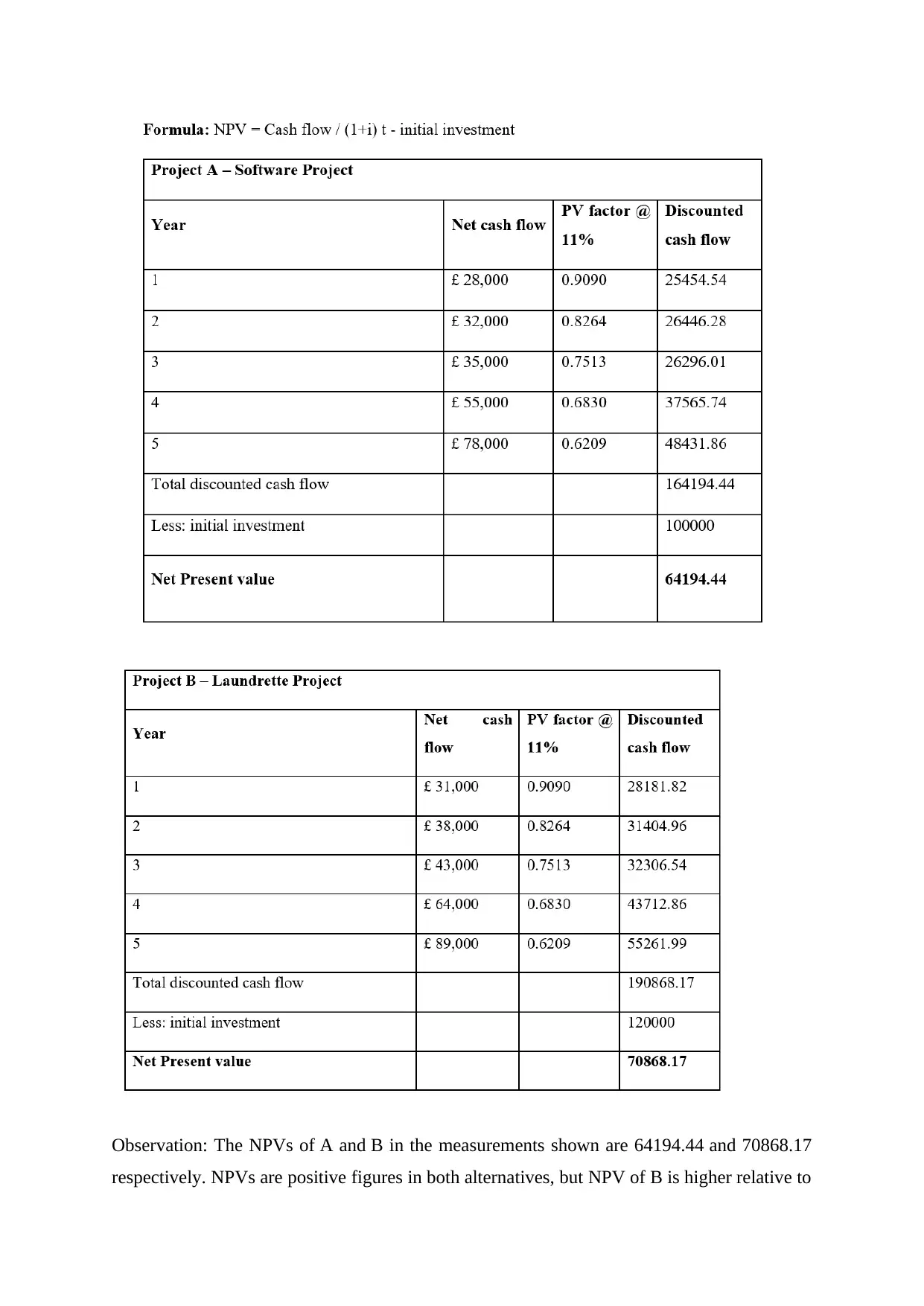
Observation: The NPVs of A and B in the measurements shown are 64194.44 and 70868.17
respectively. NPVs are positive figures in both alternatives, but NPV of B is higher relative to
respectively. NPVs are positive figures in both alternatives, but NPV of B is higher relative to
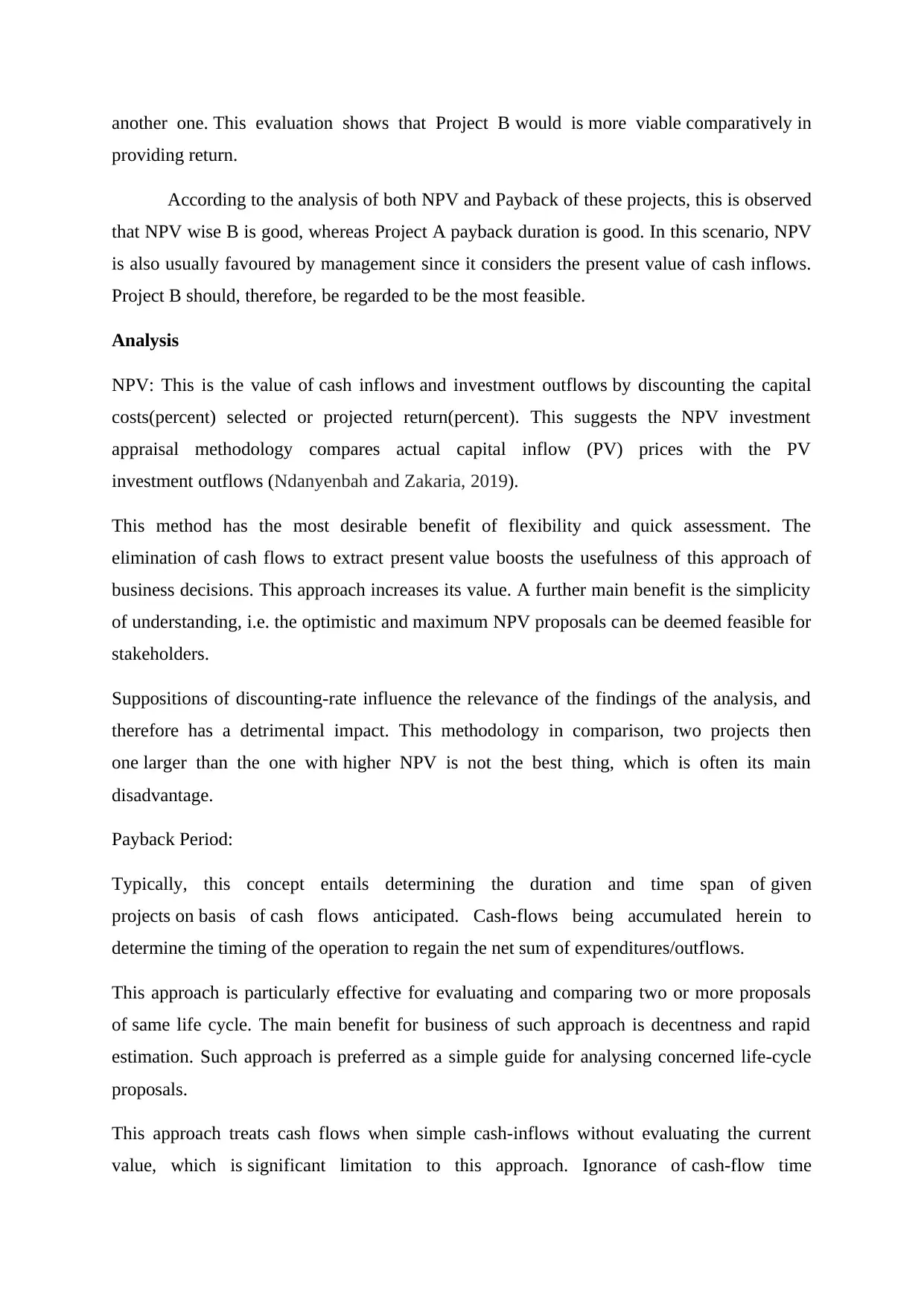
another one. This evaluation shows that Project B would is more viable comparatively in
providing return.
According to the analysis of both NPV and Payback of these projects, this is observed
that NPV wise B is good, whereas Project A payback duration is good. In this scenario, NPV
is also usually favoured by management since it considers the present value of cash inflows.
Project B should, therefore, be regarded to be the most feasible.
Analysis
NPV: This is the value of cash inflows and investment outflows by discounting the capital
costs(percent) selected or projected return(percent). This suggests the NPV investment
appraisal methodology compares actual capital inflow (PV) prices with the PV
investment outflows (Ndanyenbah and Zakaria, 2019).
This method has the most desirable benefit of flexibility and quick assessment. The
elimination of cash flows to extract present value boosts the usefulness of this approach of
business decisions. This approach increases its value. A further main benefit is the simplicity
of understanding, i.e. the optimistic and maximum NPV proposals can be deemed feasible for
stakeholders.
Suppositions of discounting-rate influence the relevance of the findings of the analysis, and
therefore has a detrimental impact. This methodology in comparison, two projects then
one larger than the one with higher NPV is not the best thing, which is often its main
disadvantage.
Payback Period:
Typically, this concept entails determining the duration and time span of given
projects on basis of cash flows anticipated. Cash-flows being accumulated herein to
determine the timing of the operation to regain the net sum of expenditures/outflows.
This approach is particularly effective for evaluating and comparing two or more proposals
of same life cycle. The main benefit for business of such approach is decentness and rapid
estimation. Such approach is preferred as a simple guide for analysing concerned life-cycle
proposals.
This approach treats cash flows when simple cash-inflows without evaluating the current
value, which is significant limitation to this approach. Ignorance of cash-flow time
providing return.
According to the analysis of both NPV and Payback of these projects, this is observed
that NPV wise B is good, whereas Project A payback duration is good. In this scenario, NPV
is also usually favoured by management since it considers the present value of cash inflows.
Project B should, therefore, be regarded to be the most feasible.
Analysis
NPV: This is the value of cash inflows and investment outflows by discounting the capital
costs(percent) selected or projected return(percent). This suggests the NPV investment
appraisal methodology compares actual capital inflow (PV) prices with the PV
investment outflows (Ndanyenbah and Zakaria, 2019).
This method has the most desirable benefit of flexibility and quick assessment. The
elimination of cash flows to extract present value boosts the usefulness of this approach of
business decisions. This approach increases its value. A further main benefit is the simplicity
of understanding, i.e. the optimistic and maximum NPV proposals can be deemed feasible for
stakeholders.
Suppositions of discounting-rate influence the relevance of the findings of the analysis, and
therefore has a detrimental impact. This methodology in comparison, two projects then
one larger than the one with higher NPV is not the best thing, which is often its main
disadvantage.
Payback Period:
Typically, this concept entails determining the duration and time span of given
projects on basis of cash flows anticipated. Cash-flows being accumulated herein to
determine the timing of the operation to regain the net sum of expenditures/outflows.
This approach is particularly effective for evaluating and comparing two or more proposals
of same life cycle. The main benefit for business of such approach is decentness and rapid
estimation. Such approach is preferred as a simple guide for analysing concerned life-cycle
proposals.
This approach treats cash flows when simple cash-inflows without evaluating the current
value, which is significant limitation to this approach. Ignorance of cash-flow time
⊘ This is a preview!⊘
Do you want full access?
Subscribe today to unlock all pages.

Trusted by 1+ million students worldwide
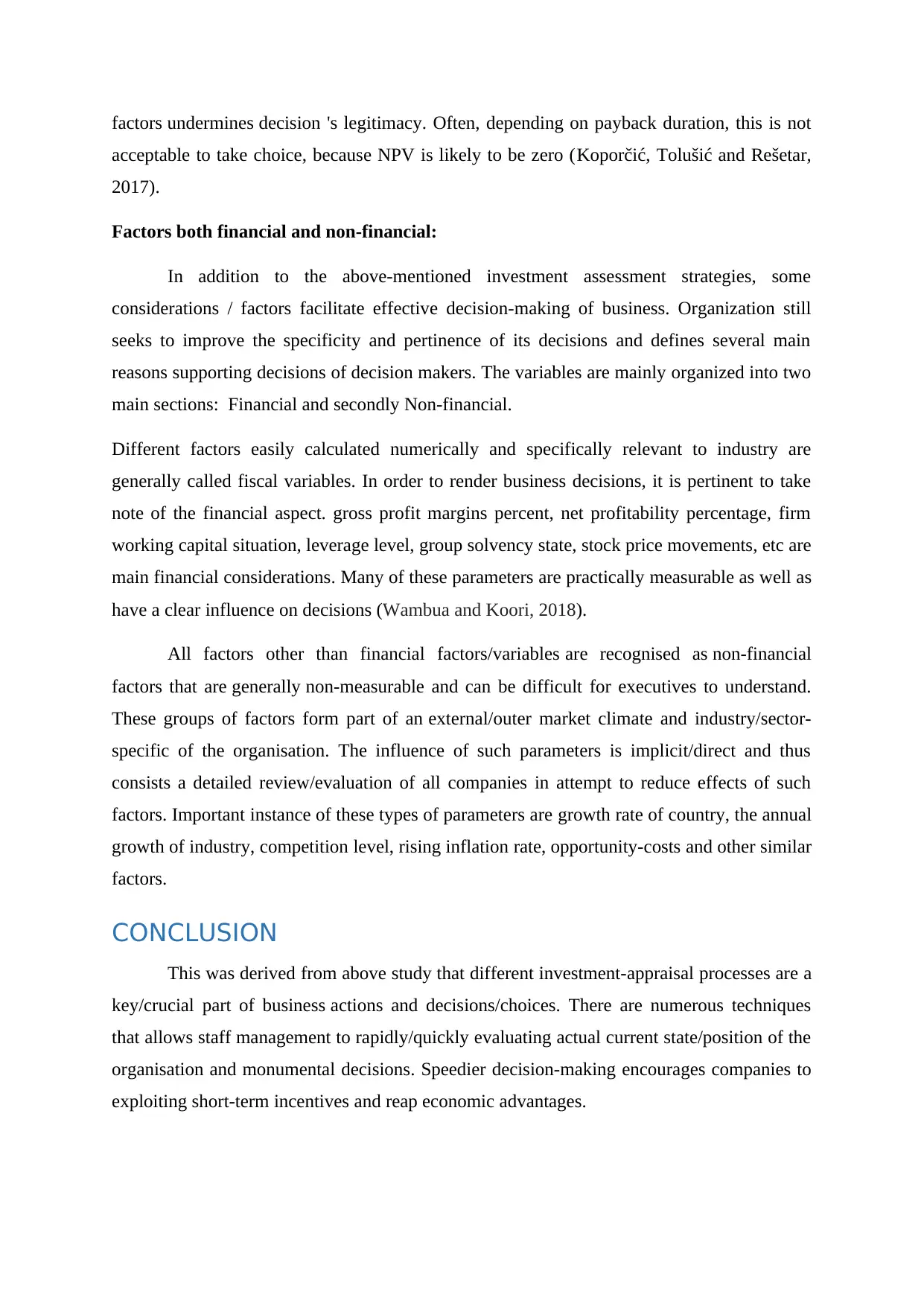
factors undermines decision 's legitimacy. Often, depending on payback duration, this is not
acceptable to take choice, because NPV is likely to be zero (Koporčić, Tolušić and Rešetar,
2017).
Factors both financial and non-financial:
In addition to the above-mentioned investment assessment strategies, some
considerations / factors facilitate effective decision-making of business. Organization still
seeks to improve the specificity and pertinence of its decisions and defines several main
reasons supporting decisions of decision makers. The variables are mainly organized into two
main sections: Financial and secondly Non-financial.
Different factors easily calculated numerically and specifically relevant to industry are
generally called fiscal variables. In order to render business decisions, it is pertinent to take
note of the financial aspect. gross profit margins percent, net profitability percentage, firm
working capital situation, leverage level, group solvency state, stock price movements, etc are
main financial considerations. Many of these parameters are practically measurable as well as
have a clear influence on decisions (Wambua and Koori, 2018).
All factors other than financial factors/variables are recognised as non-financial
factors that are generally non-measurable and can be difficult for executives to understand.
These groups of factors form part of an external/outer market climate and industry/sector-
specific of the organisation. The influence of such parameters is implicit/direct and thus
consists a detailed review/evaluation of all companies in attempt to reduce effects of such
factors. Important instance of these types of parameters are growth rate of country, the annual
growth of industry, competition level, rising inflation rate, opportunity-costs and other similar
factors.
CONCLUSION
This was derived from above study that different investment-appraisal processes are a
key/crucial part of business actions and decisions/choices. There are numerous techniques
that allows staff management to rapidly/quickly evaluating actual current state/position of the
organisation and monumental decisions. Speedier decision-making encourages companies to
exploiting short-term incentives and reap economic advantages.
acceptable to take choice, because NPV is likely to be zero (Koporčić, Tolušić and Rešetar,
2017).
Factors both financial and non-financial:
In addition to the above-mentioned investment assessment strategies, some
considerations / factors facilitate effective decision-making of business. Organization still
seeks to improve the specificity and pertinence of its decisions and defines several main
reasons supporting decisions of decision makers. The variables are mainly organized into two
main sections: Financial and secondly Non-financial.
Different factors easily calculated numerically and specifically relevant to industry are
generally called fiscal variables. In order to render business decisions, it is pertinent to take
note of the financial aspect. gross profit margins percent, net profitability percentage, firm
working capital situation, leverage level, group solvency state, stock price movements, etc are
main financial considerations. Many of these parameters are practically measurable as well as
have a clear influence on decisions (Wambua and Koori, 2018).
All factors other than financial factors/variables are recognised as non-financial
factors that are generally non-measurable and can be difficult for executives to understand.
These groups of factors form part of an external/outer market climate and industry/sector-
specific of the organisation. The influence of such parameters is implicit/direct and thus
consists a detailed review/evaluation of all companies in attempt to reduce effects of such
factors. Important instance of these types of parameters are growth rate of country, the annual
growth of industry, competition level, rising inflation rate, opportunity-costs and other similar
factors.
CONCLUSION
This was derived from above study that different investment-appraisal processes are a
key/crucial part of business actions and decisions/choices. There are numerous techniques
that allows staff management to rapidly/quickly evaluating actual current state/position of the
organisation and monumental decisions. Speedier decision-making encourages companies to
exploiting short-term incentives and reap economic advantages.
Paraphrase This Document
Need a fresh take? Get an instant paraphrase of this document with our AI Paraphraser
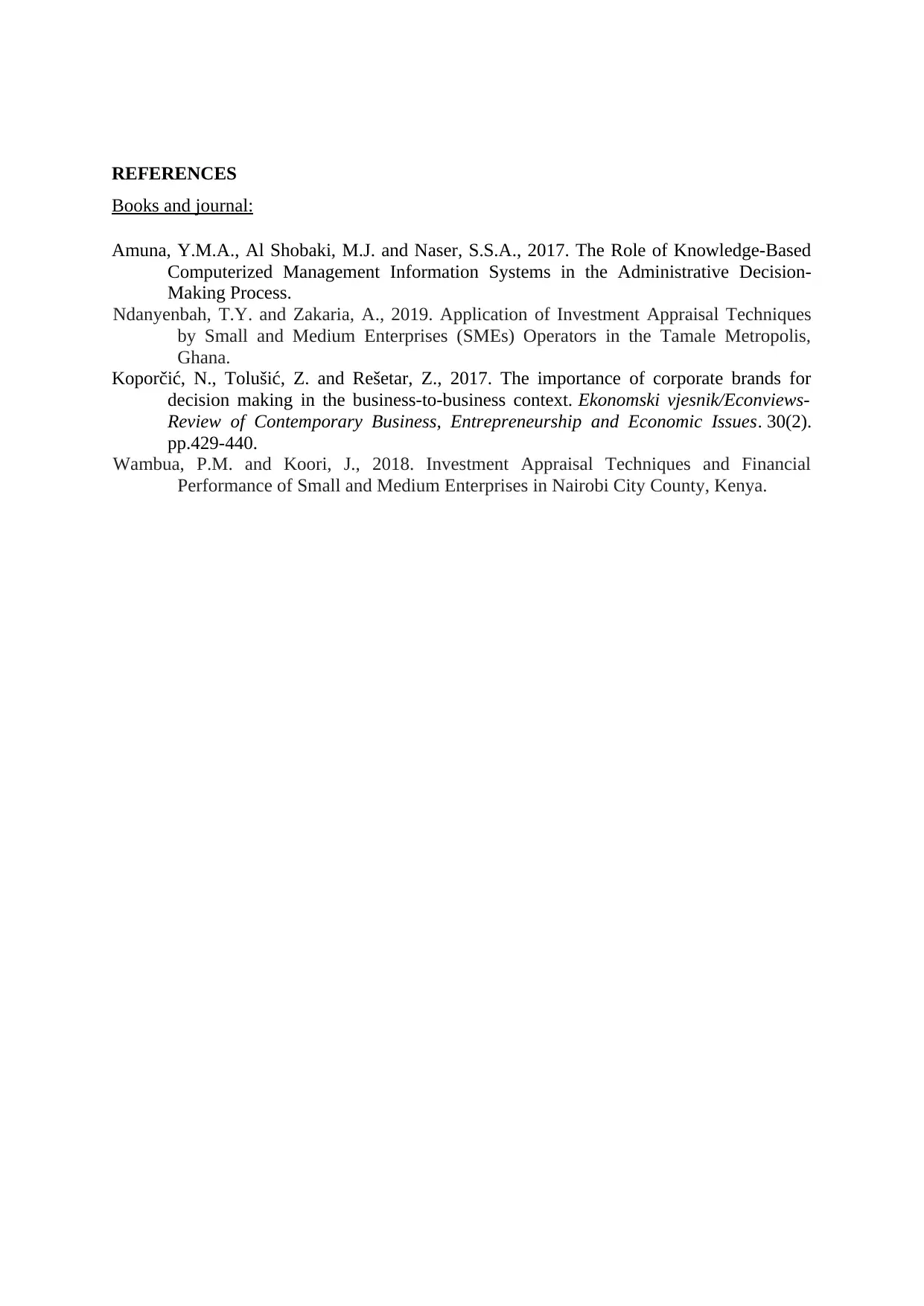
REFERENCES
Books and journal:
Amuna, Y.M.A., Al Shobaki, M.J. and Naser, S.S.A., 2017. The Role of Knowledge-Based
Computerized Management Information Systems in the Administrative Decision-
Making Process.
Ndanyenbah, T.Y. and Zakaria, A., 2019. Application of Investment Appraisal Techniques
by Small and Medium Enterprises (SMEs) Operators in the Tamale Metropolis,
Ghana.
Koporčić, N., Tolušić, Z. and Rešetar, Z., 2017. The importance of corporate brands for
decision making in the business-to-business context. Ekonomski vjesnik/Econviews-
Review of Contemporary Business, Entrepreneurship and Economic Issues. 30(2).
pp.429-440.
Wambua, P.M. and Koori, J., 2018. Investment Appraisal Techniques and Financial
Performance of Small and Medium Enterprises in Nairobi City County, Kenya.
Books and journal:
Amuna, Y.M.A., Al Shobaki, M.J. and Naser, S.S.A., 2017. The Role of Knowledge-Based
Computerized Management Information Systems in the Administrative Decision-
Making Process.
Ndanyenbah, T.Y. and Zakaria, A., 2019. Application of Investment Appraisal Techniques
by Small and Medium Enterprises (SMEs) Operators in the Tamale Metropolis,
Ghana.
Koporčić, N., Tolušić, Z. and Rešetar, Z., 2017. The importance of corporate brands for
decision making in the business-to-business context. Ekonomski vjesnik/Econviews-
Review of Contemporary Business, Entrepreneurship and Economic Issues. 30(2).
pp.429-440.
Wambua, P.M. and Koori, J., 2018. Investment Appraisal Techniques and Financial
Performance of Small and Medium Enterprises in Nairobi City County, Kenya.
1 out of 8
Related Documents
Your All-in-One AI-Powered Toolkit for Academic Success.
+13062052269
info@desklib.com
Available 24*7 on WhatsApp / Email
![[object Object]](/_next/static/media/star-bottom.7253800d.svg)
Unlock your academic potential
Copyright © 2020–2025 A2Z Services. All Rights Reserved. Developed and managed by ZUCOL.





